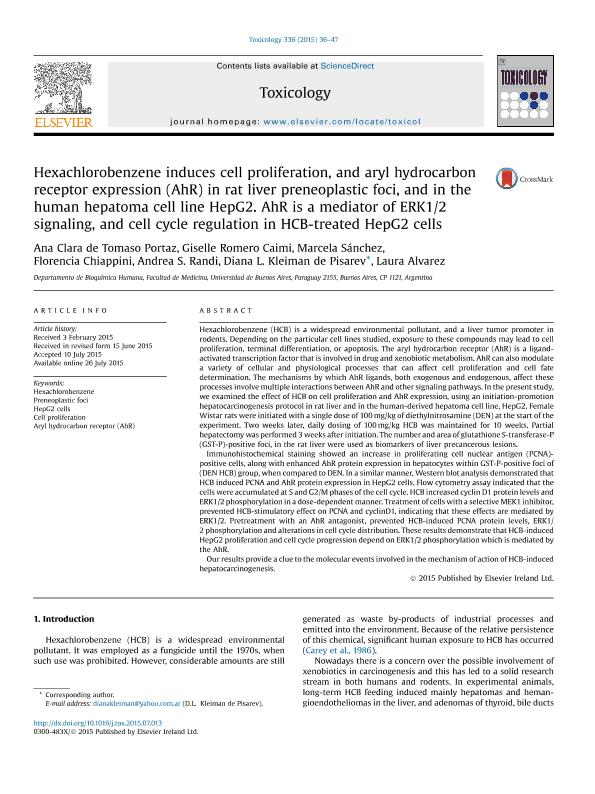Artículo
Hexachlorobenzene induces cell proliferation, and aryl hydrocarbon receptor expression (AhR) in rat liver preneoplastic foci, and in the human hepatoma cell line HepG2. AhR is a mediator of ERK1/2 signaling, and cell cycle regulation in HCB-treated HepG2 cells
de Tomaso Portaz, Ana Clara ; Romero Caimi, Vanesa Giselle; Sánchez, Marcela; Chiappini, Florencia Ana
; Romero Caimi, Vanesa Giselle; Sánchez, Marcela; Chiappini, Florencia Ana ; Randi, Andrea Silvana
; Randi, Andrea Silvana ; Kleiman, Diana Leonor
; Kleiman, Diana Leonor ; Alvarez, Laura
; Alvarez, Laura
 ; Romero Caimi, Vanesa Giselle; Sánchez, Marcela; Chiappini, Florencia Ana
; Romero Caimi, Vanesa Giselle; Sánchez, Marcela; Chiappini, Florencia Ana ; Randi, Andrea Silvana
; Randi, Andrea Silvana ; Kleiman, Diana Leonor
; Kleiman, Diana Leonor ; Alvarez, Laura
; Alvarez, Laura
Fecha de publicación:
10/2015
Editorial:
Elsevier Ireland
Revista:
Toxicology
ISSN:
0300-483X
Idioma:
Inglés
Tipo de recurso:
Artículo publicado
Clasificación temática:
Resumen
Hexachlorobenzene (HCB) is a widespread environmental pollutant, and a liver tumor promoter in rodents. Depending on the particular cell lines studied, exposure to these compounds may lead to cell proliferation, terminal differentiation, or apoptosis. The aryl hydrocarbon receptor (AhR) is a ligand-activated transcription factor that is involved in drug and xenobiotic metabolism. AhR can also modulate a variety of cellular and physiological processes that can affect cell proliferation and cell fate determination. The mechanisms by which AhR ligands, both exogenous and endogenous, affect these processes involve multiple interactions between AhR and other signaling pathways. In the present study, we examined the effect of HCB on cell proliferation and AhR expression, using an initiation-promotion hepatocarcinogenesis protocol in rat liver and in the human-derived hepatoma cell line, HepG2. Female Wistar rats were initiated with a single dose of 100. mg/kg of diethylnitrosamine (DEN) at the start of the experiment. Two weeks later, daily dosing of 100. mg/kg HCB was maintained for 10 weeks. Partial hepatectomy was performed 3 weeks after initiation. The number and area of glutathione S-transferase-P (GST-P)-positive foci, in the rat liver were used as biomarkers of liver precancerous lesions.Immunohistochemical staining showed an increase in proliferating cell nuclear antigen (PCNA)-positive cells, along with enhanced AhR protein expression in hepatocytes within GST-P-positive foci of (DEN HCB) group, when compared to DEN. In a similar manner, Western blot analysis demonstrated that HCB induced PCNA and AhR protein expression in HepG2 cells. Flow cytometry assay indicated that the cells were accumulated at S and G2/M phases of the cell cycle. HCB increased cyclin D1 protein levels and ERK1/2 phosphorylation in a dose-dependent manner. Treatment of cells with a selective MEK1 inhibitor, prevented HCB-stimulatory effect on PCNA and cyclinD1, indicating that these effects are mediated by ERK1/2. Pretreatment with an AhR antagonist, prevented HCB-induced PCNA protein levels, ERK1/2 phosphorylation and alterations in cell cycle distribution. These results demonstrate that HCB-induced HepG2 proliferation and cell cycle progression depend on ERK1/2 phosphorylation which is mediated by the AhR.Our results provide a clue to the molecular events involved in the mechanism of action of HCB-induced hepatocarcinogenesis.
Archivos asociados
Licencia
Identificadores
Colecciones
Articulos(OCA HOUSSAY)
Articulos de OFICINA DE COORDINACION ADMINISTRATIVA HOUSSAY
Articulos de OFICINA DE COORDINACION ADMINISTRATIVA HOUSSAY
Citación
de Tomaso Portaz, Ana Clara; Romero Caimi, Vanesa Giselle; Sánchez, Marcela; Chiappini, Florencia Ana; Randi, Andrea Silvana; et al.; Hexachlorobenzene induces cell proliferation, and aryl hydrocarbon receptor expression (AhR) in rat liver preneoplastic foci, and in the human hepatoma cell line HepG2. AhR is a mediator of ERK1/2 signaling, and cell cycle regulation in HCB-treated HepG2 cells; Elsevier Ireland; Toxicology; 336; 10-2015; 36-47
Compartir
Altmétricas



